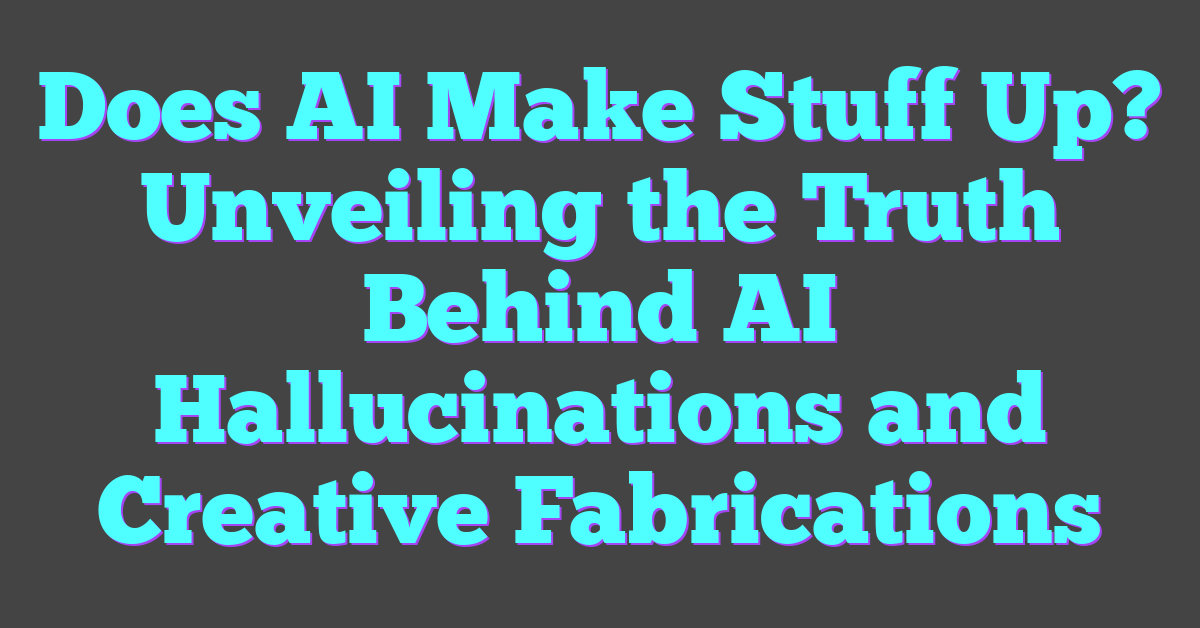In a world where artificial intelligence is becoming a staple in our daily lives, a curious question arises: does AI make stuff up? From chatbots to virtual assistants, AI systems often surprise users with their responses, sometimes leading to unexpected or even fabricated information. This phenomenon, known as “hallucination” in AI, can be both fascinating and perplexing.
Understanding why and how AI generates these imaginative outputs is crucial. It sheds light on the limitations and potential pitfalls of relying on AI for accurate information. While AI can process vast amounts of data at lightning speed, it doesn’t always get it right. So, let’s dive into the intriguing world of AI hallucinations and explore what causes these digital daydreams.
Understanding AI and Creativity
AI and creativity intersect in fascinating ways, with AI systems producing content that sometimes appears imaginative or even fabricated. To better grasp this phenomenon, it’s crucial to understand how AI generates content and the specific challenges it faces in the creative processes.

How AI Generates Content
AI uses various algorithms, including neural networks, to analyze and generate content. Machine learning models, particularly those involving Natural Language Processing (NLP), first train on large datasets containing diverse text. These models learn patterns, context, and structure within the data.
- Pattern Recognition: AI identifies recurring themes and structures.
- Context Analysis: AI understands word relationships and context.
- Text Generation: AI uses learned patterns to create new content.
For instance, OpenAI’s GPT-3 model employs 175 billion parameters, making it one of the largest language models. It can generate coherent text based on initial prompts, mimicking human-like writing styles.
Challenges in AI’s Creative Processes
While AI excels in generating content, it faces several challenges in the creative process. These obstacles stem from inherent limitations in machine learning and the complexity of human creativity.
- Data Limitations: AI’s output is only as good as the data it trains on. Biased or low-quality data can lead to inaccurate or nonsensical results.
- Context Misunderstanding: AI sometimes misinterprets context, leading to outputs that don’t align with user intent.
- Inventive Hallucinations: AI may produce entirely fictional or irrelevant content, misleading users if not properly monitored.
For example, when generating stories or articles, AI can blend factual and fictional information, producing plausible but incorrect narratives. This phenomenon, called hallucination, demonstrates AI’s current limitations in creative endeavors.
Understanding these challenges helps users and developers improve AI systems, making them more reliable and effective content creators.
Does AI Make Stuff Up?
Yes, AI can indeed make stuff up. This process is often called “hallucination,” where AI generates content that seems plausible but is based on fabricated or misunderstood data. As an expert in artificial intelligence (AI) and machine learning, it’s critical to examine both the mechanics and implications of this phenomenon.
Examining AI’s Ability to Invent
AI systems, particularly those using neural networks, can generate detailed, human-like text. They achieve this by analyzing vast datasets and learning patterns in the data. However, when these models encounter gaps or ambiguous input, they can create entirely fictional content. This is especially evident in models like GPT-3, which can produce coherent, imaginative stories but also may generate baseless but seemingly plausible information.
For example, a neural network trained on historical texts might write a detailed-yet-fictional account of an event that never occurred if it encounters incomplete or inconsistent data. The AI’s ability to “invent” is both a testament to its complex algorithms and a limitation due to potential inaccuracies.
Case Studies: AI in Art and Writing
Numerous examples in art and writing illustrate AI’s ability to fabricate or “hallucinate.” For instance, AI artists like AICAN create original artworks by interpreting and crafting pieces based on existing art movements. While these creations are unique, they often combine elements from various sources, sometimes resulting in entirely new and invented artistic styles.
In writing, AI, such as GPT-3, has crafted short stories and articles that often blend factual data with imaginative elements. A notable case involved AI-generated content for fictional scenarios, such as futuristic worlds or alternative histories. While these narratives can be engaging, they underscore AI’s potential to fabricate information when generating creative content.
Through these examples, it’s clear that AI’s inventive capabilities are both impressive and a reminder of the importance of oversight in its application, ensuring content remains reliable and effective.
Implications of AI-Created Content
AI’s ability to generate content has transformative implications across various sectors, raising both ethical concerns and impacting professional fields.
Ethical Considerations
AI-generated content poses significant ethical questions. Misinformation is a major concern when AI creates fabricated details. For instance, language models like GPT-3 can produce plausible yet false statements, which may mislead audiences. Copyright issues also arise since AI can mimic styles of human creators without credit, blurring the lines of intellectual property.
Impact on Professional Fields
Several professions face changes due to AI-generated content. Journalism sees rapid content creation, but risks accuracy and credibility if AI includes errors or creates fictional scenarios. In education, AI assists with tutoring and content generation but may provide incorrect or biased information. Creative fields like art and writing benefit from AI-driven innovation, yet rely on human oversight to ensure authenticity and originality.
AI-generated content redefines the landscape of content creation, presenting both opportunities and challenges that require careful navigation.
Conclusion
As AI continues to evolve it’s clear that its ability to generate content brings both excitement and concern. While AI can create imaginative and impressive works it also poses risks when it comes to accuracy and authenticity. Balancing innovation with ethical considerations is key to harnessing AI’s potential without sacrificing trust. The future of AI in content creation holds promise but it requires vigilant oversight to ensure it serves as a reliable tool rather than a source of misinformation.
Frequently Asked Questions
What is AI hallucination?
AI hallucination refers to instances where artificial intelligence systems generate imaginative or fabricated content that is not based on the factual data they have been trained on.
How does AI hallucination occur?
AI hallucination occurs when AI models, like neural networks, misinterpret data or fill in gaps with invented information due to data limitations or ambiguous context.
What are the implications of AI hallucination?
The implications include the risk of misinformation, ethical issues related to content authenticity, and potential challenges in fields like journalism, education, and creative industries.
Can AI-generated content be reliable?
AI-generated content can be reliable, but it requires careful monitoring and verification to ensure accuracy and authenticity, especially to avoid the pitfalls of AI hallucination.
How does AI hallucination affect creative industries?
In creative industries, AI hallucination can both inspire new ideas and present risks of inaccuracy or misinformation. It necessitates a balance between creative freedom and reliable content.
Are there ethical concerns related to AI hallucination?
Yes, ethical concerns include the potential for spreading misinformation, violating copyright laws, and compromising the integrity of professional fields relying on accurate information.
How can AI hallucination be mitigated?
Mitigation involves improving AI training data, refining algorithms to better handle ambiguous information, and implementing robust verification processes to ensure content accuracy.
What role does data play in AI hallucination?
Data is crucial; limited or low-quality data can lead to higher chances of AI hallucination as the system may struggle to fill in gaps accurately.
Why is context important for AI content generation?
Context is vital for ensuring the AI interprets and generates content accurately, avoiding the creation of irrelevant or fabricated information.
What challenges does AI hallucination present?
Challenges include managing the accuracy of AI-generated content, addressing ethical concerns, and ensuring that content creation in professional fields remains reliable and credible.




